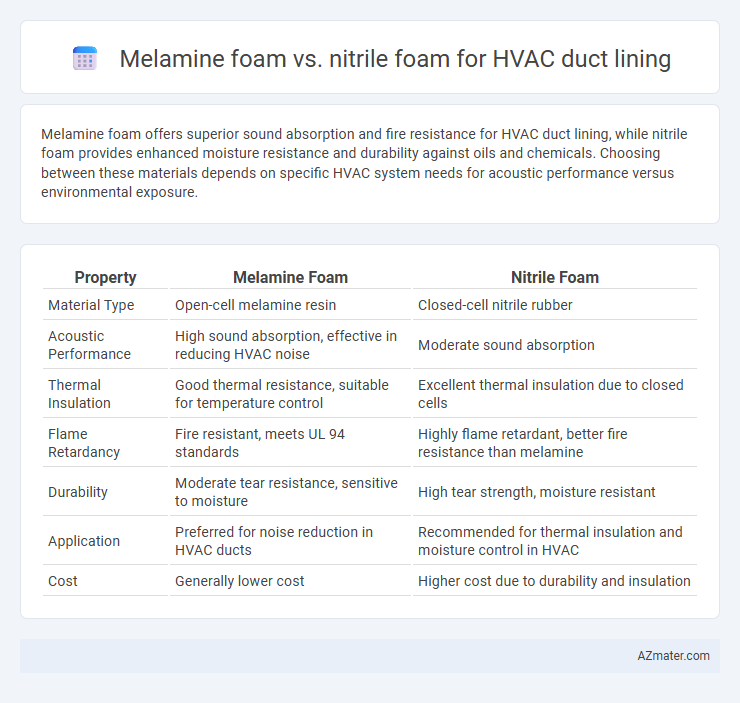Melamine foam offers superior sound absorption and fire resistance for HVAC duct lining, while nitrile foam provides enhanced moisture resistance and durability against oils and chemicals. Choosing between these materials depends on specific HVAC system needs for acoustic performance versus environmental exposure.
Table of Comparison
| Property | Melamine Foam | Nitrile Foam |
|---|---|---|
| Material Type | Open-cell melamine resin | Closed-cell nitrile rubber |
| Acoustic Performance | High sound absorption, effective in reducing HVAC noise | Moderate sound absorption |
| Thermal Insulation | Good thermal resistance, suitable for temperature control | Excellent thermal insulation due to closed cells |
| Flame Retardancy | Fire resistant, meets UL 94 standards | Highly flame retardant, better fire resistance than melamine |
| Durability | Moderate tear resistance, sensitive to moisture | High tear strength, moisture resistant |
| Application | Preferred for noise reduction in HVAC ducts | Recommended for thermal insulation and moisture control in HVAC |
| Cost | Generally lower cost | Higher cost due to durability and insulation |
Introduction to HVAC Duct Lining Materials
Melamine foam and nitrile foam are two prominent materials used for HVAC duct lining, each offering distinct acoustic and thermal insulation properties. Melamine foam excels in sound absorption due to its open-cell structure, making it ideal for noise reduction in HVAC systems, while nitrile foam provides superior resistance to moisture, chemicals, and high temperatures, enhancing duct durability and longevity. Selecting the appropriate foam depends on balancing factors such as acoustic performance, thermal insulation, fire resistance, and environmental conditions specific to the HVAC application.
Overview of Melamine Foam
Melamine foam offers superior thermal insulation and excellent acoustic absorption, making it ideal for HVAC duct lining applications where noise reduction and temperature control are critical. Its open-cell structure provides high porosity while maintaining fire resistance and low smoke emission, complying with strict building codes. Melamine foam is lightweight, environmentally friendly, and resistant to moisture and microbial growth, ensuring durability and indoor air quality in HVAC systems.
Overview of Nitrile Foam
Nitrile foam is a synthetic rubber material renowned for its excellent resistance to oils, chemicals, and temperature variations, making it highly suitable for HVAC duct lining applications. Its closed-cell structure provides superior moisture resistance and durability compared to melamine foam, which is open-cell and primarily valued for thermal and acoustic insulation. Nitrile foam's ability to maintain structural integrity in harsh environments ensures long-lasting performance in commercial and industrial HVAC systems.
Acoustic Performance Comparison
Melamine foam offers superior acoustic absorption for HVAC duct lining due to its open-cell structure, effectively reducing mid-to-high frequency noise within the ventilation system. Nitrile foam, while providing good thermal insulation and moisture resistance, has a denser, closed-cell composition that limits its sound absorption capabilities compared to melamine foam. Studies show melamine foam can achieve Noise Reduction Coefficient (NRC) values up to 0.8, significantly outperforming nitrile foam, which generally exhibits NRC ratings below 0.5 in HVAC acoustic applications.
Thermal Insulation Properties
Melamine foam offers superior thermal insulation due to its open-cell structure, providing low thermal conductivity and excellent heat resistance suitable for HVAC duct lining. Nitrile foam, while durable and resistant to oils and chemicals, generally exhibits higher thermal conductivity, resulting in less efficient insulation performance in high-temperature environments. For optimal thermal insulation in HVAC applications, melamine foam is preferred because of its enhanced fire retardancy and ability to maintain consistent thermal resistance over time.
Fire Resistance and Safety Ratings
Melamine foam exhibits superior fire resistance compared to nitrile foam, as it is inherently flame retardant and meets stringent fire safety standards such as UL 94 and ASTM E84 Class A ratings. Nitrile foam, while offering good thermal insulation and chemical resistance, typically ranks lower in fire safety due to its combustible nature and may require additional treatments to improve flame retardancy. For HVAC duct lining applications prioritizing fire safety, melamine foam is preferred for its low smoke production, self-extinguishing properties, and compliance with rigorous safety certifications.
Durability and Longevity
Melamine foam offers excellent thermal insulation and sound absorption but tends to have lower durability and shorter lifespan compared to nitrile foam when used for HVAC duct lining. Nitrile foam exhibits superior resistance to moisture, chemicals, and physical wear, resulting in enhanced longevity and reduced maintenance costs in duct applications. HVAC systems lined with nitrile foam benefit from prolonged structural integrity and consistent performance under varying environmental conditions.
Installation and Maintenance Considerations
Melamine foam offers lightweight installation with excellent fire resistance and sound absorption properties, making it easier to handle and fit in HVAC duct applications. Nitrile foam provides superior durability and moisture resistance, requiring less frequent maintenance in environments prone to condensation or chemical exposure. Proper installation of melamine foam mandates careful sealing to prevent dust release, while nitrile foam installation focuses on ensuring tight adhesion to duct surfaces to maintain its protective qualities over time.
Cost Analysis: Melamine vs Nitrile Foam
Melamine foam typically offers lower upfront costs compared to nitrile foam, making it a cost-effective choice for HVAC duct lining in budget-sensitive projects. Nitrile foam, while more expensive initially, provides enhanced durability, chemical resistance, and longer lifespan, which can reduce replacement and maintenance expenses over time. Evaluating lifecycle cost analysis often favors nitrile foam in high-demand environments despite its higher initial price due to superior performance and reduced operational disruptions.
Best Applications and Final Recommendations
Melamine foam excels in HVAC duct lining due to its superior acoustic absorption and fire-resistant properties, making it ideal for residential and commercial environments requiring noise reduction and safety compliance. Nitrile foam offers enhanced resistance to oils, chemicals, and moisture, favoring industrial HVAC systems where exposure to harsh environments and contaminants is common. For optimal HVAC duct performance, choose melamine foam in applications prioritizing sound control and fire safety, while nitrile foam is recommended for systems demanding durability against chemical exposure and humidity.

Infographic: Melamine foam vs Nitrile foam for HVAC duct lining
 azmater.com
azmater.com